Don’t Forget To Clean These Germ-Infested Items In Your Home!
1 Remote Control
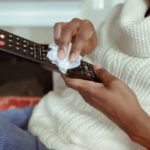
Remote controls often get handled and passed around between family members, so this is one household item that needs regular cleaning. You wouldn’t believe that amount of germs that can collect on the surface. What’s the correct way to disinfect your remote?
The best products to use are alcohol or bleach-based wipes. First, remove the batteries and shake the remote control upside down to allow any loose debris to fall off. Then clean it with the wipe. If you’re using spray cleaning products, spray the solution onto a paper towel, and then wipe it off. Never spray liquid directly onto the device.
2 Door Knobs

There are several “high touch” areas in your home that often get overlooked in cleaning. Don’t forget to sanitize all the doorknobs from time to time. They receive some of the most physical contact of any other household item and can collect a lot of bacteria.
Looking for a non-toxic and natural way to sanitize doorknobs? Here’s a simple solution that would do the trick. Pour a 50/50 mix of water and vinegar in a spray bottle and spray it onto the surface. Allow it to sit for a few minutes, then wipe it off with a towel.
3 Cell Phone Screens

We all know that germs can linger on surfaces for days, and one item that people touch on and off all day is their cell phone. It goes everywhere and many of us don’t think to wash our hands before scrolling away on our screens. This means it’s a hot spot for germs.
According to Good Housekeeping, experts suggest that you clean your cell phone twice a week. The steps are to remove it from the case and power it down. Next, wipe it with a microfiber cloth and gently clean it with a Lysol wipe. Finally, rub it down with a paper towel.
4 Eye Glasses
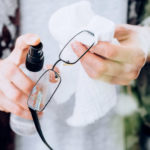
Those who wear glasses know that the specs can provide protection from germs spread through sneezes and coughs. Don’t be fooled into thinking you’re off the hook because bacteria can lurk on the lenses. Ideally, you should clean your glasses every day to keep them germ-free.
Dr. Barbara Horn, president of the American Optometric Association, told Today, “I’m certainly not saying glasses are the main culprit by any means, but you just always want to be careful—making sure you’re cognizant of the fact that glasses can transfer (the virus) and be aware of how to clean them properly.”
5 Reusable Grocery Bags

Earth-conscious consumers prefer to put their groceries in reusable cloth bags. It’s great for the environment, but if the bags aren’t cleaned regularly, they can be a breeding ground for bacteria. Be sure to sanitize them to make sure you keep your family safe from germs.
The Cleaning Institute gave these instructions on the most effective way to clean your reusable bags. “Wash bags after each use, following care instructions. See the fabric care label […]. Wipe insulated bags with a disinfecting or sanitizing cloth, especially along the seams,” they suggested on their website.
6 Yoga Mats

Rather, you’ve ventured out to the Yoga Studio or you practice at home, your yoga mat needs to be cleaned often since it’s exposed to oils on the skin and other germs. You can use a bleach-free alcohol wipe to sanitize it or Martha Stewart has an unexpected cleaning tip.
“The best way to get your yoga mat clean is to bring it in the shower with you. You can use soap or even body wash, as long as you work up a thorough lather on the mat before rinsing it completely,” she wrote. Then hang it outside to dry.
7 Keys
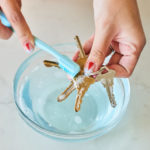
You can protect your family from germs by making sure that “high touch” items are washed often. Be sure to clean your keys at least once a week, since they can easily spread viruses and bacteria. They often get exposed to germs and can be passed around without a thought.
The process is simple. You’ll need dish soap, a bowl, a toothbrush, and a towel. The first step is to remove any keys with computer chips, car remote controls, and decorative items. Mix a drop of dish soap into the water. Swish your keys through the solution and use a toothbrush to clean the keys.
8 Cutting Boards
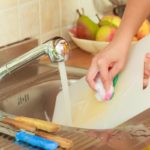
When it comes to keeping your kitchen clean, there are several items that require a good scrubbing so they don’t become a breeding ground for germs. It’s important to clean and sanitize cutting boards, to avoid food-borne bacteria.
It’s fine to disinfect plastic cutting boards in the dishwasher, but wooden cutting boards should be hand washed because water exposure causes them to crack. Rinse the board with hot water and apply dish soap. Scrub it with a brush or a sponge, then give it a rinse. For more stubborn stains, sprinkle the board with salt and run half a lemon over the surface.
9 Kitchen Hand Towels

It’s easy to overlook the obvious, so we’d be remiss not to remind everyone to wash their kitchen dish towels. These handy little towels are good for cleaning up everything. From soaking up spills to wiping off our hands, they serve many purposes.
This means that dish towels are often covered in germs, and can spread a cold or other illness to all members of a household. They should be cleaned at least once a week, but daily cleaning would be better. Wash kitchen towels in the washing machine, using hot water. Dry them with high heat in the dryer.
10 Bedding
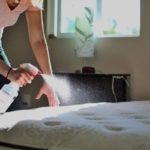
If you’re concerned about germs, then cleaning a few targeted areas of your home can offer great protection and peace of mind. Be sure to add bedding to your list of items to wash. All bedding, from comforters to pillowcases to sheets, should be washed at least twice a week.
The Centers for Disease Control and Prevention suggest that you follow the manufacturers’ washing suggestions and wash all bedding in the warmest setting the fabric allows. You should also avoid hugging the bedding when you carry it to the washing machine. Don’t shake out sheets before placing them in the machine to avoid dispersing germs.
11 Clothing
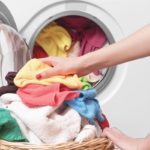
It’s crucial that you properly disinfect all clothing items during cold and flu season. It’s also important to change clothes and wash items immediately after they’ve been worn in a public place to avoid contaminating your home. This will ensure that everyone stays healthy.
Wash all clothes with standard laundry detergent at the hottest setting that the fabric will allow. Dry them on a high heat setting. Another thing to remember is to spray the laundry basket with disinfectant spray daily. Following these guidelines will ensure that your clothes are cleaned properly.
12 Makeup Brushes
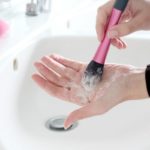
Ladies will want to pay attention to this next tip. You should wash your makeup brushes often to avoid infection. Your beauty products can collect harmful bacteria, so it’s important to disinfect them often. The Huffington Post spoke with board-certified dermatologist Dr. Susan Massick about the best way to sanitize them.
“Wash makeup brushes with warm soapy water and dry them completely (the soap itself can help kill the viruses) once weekly, or after any time you use them,” Massick said. “You can also look into purchasing disposable applicators, which are great for applying eyeshadows, blush, and powder products.”
13 Toothbrushes And Holder
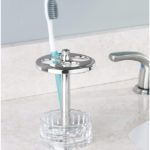
Germs are found in saliva and often transfer harmful bacteria onto your toothbrush when you brush your teeth. If other people share the same toothbrush holder, it can contaminate other people in the home. It’s crucial to practice healthy hygiene to avoid illness.
Here are a few pro-tips on how to keep your toothbrushes clean. Start off by washing your hands before you brush, disinfect the handle with a Lysol wipe after you’re finished brushing, and never, ever share your toothbrush. You can also practice dental social distancing by avoiding storing toothbrushes in the same container.
14 Light Switches

Perhaps one of the dirtiest places in your home is light switches. We all hit the usual spots when cleaning, but these probably aren’t sanitized as often as they should be. Luckily, the folks over at Good Housekeeping shared an easy and fast way to clean your light switches.
“First, spray a regular household cleaner or rubbing alcohol onto a paper towel. Be sure not to apply the solution directly to the plate. Then whip down the surface. Next, use a Q-Tip to clean the actual switch of the fixture. Finally, buff with a cloth to dry,” they suggested.
15 Computer Keyboard
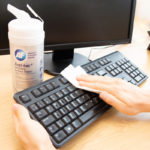
Most families own at least one computer, and various sets of dirty fingers can type away on the keyboard. It can be a hotspot for germs, so be sure to take the time to clean your computer keyboard on a regular basis.
The first step is to disconnect the keyboard from your computer. Use a slightly damp microfiber cloth to wipe the keys. You can also clean it with a disinfectant wipe to kill germs. Be sure to wring out any excess fluid and then gently wipe down the keys. Finally, run a soft cloth over the keyboard.
16 Game Controllers

Parents know just how dirty gaming controllers can be. Kids often have grubby fingers and can cover their controller in germs. Looking for the easiest and cheapest way to sanitize your child’s video game controller?
Clean My Space offered this advice. You’ll need a 50/50 mix of rubbing alcohol and water, cotton swabs, an old toothbrush, and a soft cloth. First, remove the batteries, then use the toothbrush to loosen dirt. Lightly mist the cloth with alcohol mixture and wipe down the controller. Finally, use a moist cotton ball to clean between the buttons.
17 Refrigerator Handle
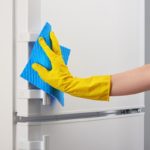
The kitchen is a hot zone for being a high touch area in your home. One appliance that is often touched by several people is the refrigerator. From kids grabbing snacks to parents prepping dinner, the refrigerator handle sees a lot of action. So, take an extra moment to clean it.
Experts suggest sanitizing the fridge handle once a week, but you might want to do it more frequently during cold and flu season. Wipe it down with a towel damped with warm water and a cleaning solution. A Lysol wipe can work in a pinch.
18 Kitchen Sponges
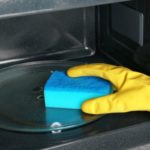
Kitchen sponges can get grimy and can often spread bacteria. There are a few ways to clean them. From popping one in the microwave for a few minutes to washing your sponge in the dishwasher, these methods will sanitize them.
Yet, according to Good Housekeeping, the most effective method is to wash sponges in bleach. They suggest mixing 3/4 cup of bleach in one gallon of water and soak the sponge for five minutes, then rinse. No matter how you clean your sponges, be sure to replace them every few weeks to keep nasty germs away.
19 Countertops
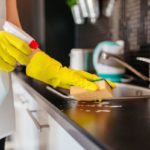
While we’re on the subject of cleaning the kitchen, here’s a friendly reminder to disinfect your countertops. All too often, kitchen counters end up being wiped down but not sanitized. There are so many potential contaminants that could infiltrate your home. From chopping up food to handling raw meat, cross-contamination can happen.
There are a few options for what sort of cleaner to use. If you’re concerned about using natural products, clean them with a solution of rubbing alcohol and water. Otherwise, a store-bought cleaning spray wiped with a moist sponge or microfiber cloth can have your countertops looking shiny.
20 The Bottom Of Your Purse

One item that goes everywhere with a lady is her purse. Many women set their handbag directly onto the shopping cart while they buy groceries or shop. This means that many germs can lurk on the bottom of your bag.
Perhaps you set it on the counter during check out to find your wallet. Either way, your purse can be a carrier of bacteria, so be sure to wipe it down when you get home. A Lysol or disinfectant wipe should take care of it. Just be sure to follow the cleaning instructions that came along with the bag so you won’t damage the material.
